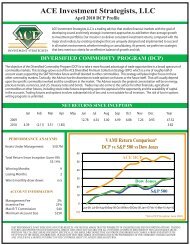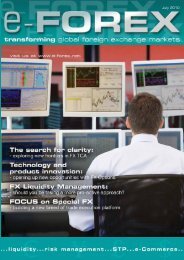Create successful ePaper yourself
Turn your PDF publications into a flip-book with our unique Google optimized e-Paper software.
and potential liquidations. FX firms will now have<br />
to collect a minimum 1% margin on the G7<br />
currencies and 4% on minor currencies. Meanwhile<br />
leverage will be capped at 100:1. Another recent<br />
regulation, enforcement of First In First Out<br />
(FIFO) position management, will prevent hedging<br />
strategies in the same trading account.<br />
These regulatory measures will have a direct and<br />
significant effect on margining techniques, forcing<br />
them to be both more flexible and granular. The<br />
move from static to variable methodologies, such as<br />
from flat rate margining to variable currency<br />
margining, has already started to branch into<br />
product, tenor, volume, concentration and<br />
customer type margining capabilities. Another such<br />
trend will likely involve customer configuration,<br />
both a narrowing towards multiple sub-accounts,<br />
which would allow users to hedge across accounts,<br />
and an expansion of customer groupings for higher<br />
level monitoring of risk.<br />
Benefit to margining<br />
The benefit of these changes to margining will be<br />
more than simply <strong>com</strong>pliance. Trading firms can<br />
also reduce their own market and credit risk on a<br />
global scale. More granular margining, by product<br />
and across products, will enable firms to expand<br />
their product offerings with increasingly<br />
sophisticated FX instruments, as they can better<br />
manage the risk associated with those products<br />
without affecting their vanilla FX margining.<br />
For FX options, risk managers have traditionally<br />
relied on delta notional margining. This is a good<br />
starting place, but in the current environment<br />
where both investors and regulators are focusing<br />
more on risk management, this may not be<br />
enough. Firms will have to go further by taking<br />
more <strong>com</strong>plex pricing and revaluation models and<br />
applying this sophistication to the margining<br />
calculations.<br />
At the same time that firms expand the <strong>com</strong>plexity<br />
of their product offerings and with algorithmic<br />
trading be<strong>com</strong>ing increasingly popular in the FX<br />
market, margining systems must be able to both<br />
manage the risks associated with <strong>com</strong>plex algodriven<br />
strategies and the higher trade volumes<br />
without sacrificing the speed of execution and the<br />
speed of margining calculations.<br />
More flexibility<br />
Faced with a future of increased regulation and ever<br />
increasing trade volumes, margin systems must be<br />
VIEWPOINT<br />
able to handle both of these trends without<br />
<strong>com</strong>promising risk management or performance.<br />
More flexible margining configurations allow<br />
broker/dealers to <strong>com</strong>ply with regulations out of<br />
the box, while allowing them to better manage<br />
their own risk. SunGard anticipates the effects that<br />
new regulations will have upon the margining<br />
sphere, and is proactive in enhancing its Sierra<br />
Advanced Margining solution to meet these new<br />
requirements. www.sungard.<strong>com</strong>/sierrafx










